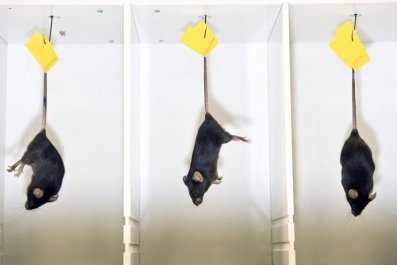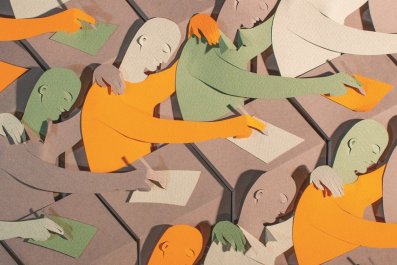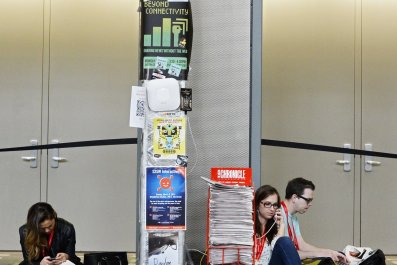The stuff that makes people worry about bitcoin—its volatility, the notion that it's a nationless currency, the bizarreness of being able to "mine" money on a computer—are all part of a brilliant ploy designed to spread the crypto-currency around the world. And it's working.
Yes, we're being tricked into adopting bitcoin, but this is necessary so that it can eventually become so effortless it can be used by grandmothers, illiterate migrant workers and even Kardashians.
That's my takeaway after discussing bitcoin with three of the most influential players in the emerging sector: tech investor Marc Andreessen, Coinbase Chief Executive Officer Brian Armstrong and SecondMarket CEO Barry Silbert. All are certain bitcoin will transform global commerce. They're also pretty certain that even some brilliant people like Warren Buffett, who recently dissed bitcoin on TV, can't see beyond the short-term wackiness to the long-term importance.
As Andreessen explained to me, bitcoin is a foundation technology—an infrastructure to be built upon. In that sense, it is like the protocols that make the Internet possible, or the alternating current that travels over the electric grid.
However, it's rarely a good idea to just build an infrastructure and hope people will come. There's a chicken/egg problem. You couldn't build an electrical grid before anything was invented to take advantage of it. But nobody would invent electric gadgets if there were no grid. Thomas Edison needed to invent the lightbulb and the grid at about the same time.
The currency called bitcoin is the lightbulb; the technology of bitcoin is the grid. Both had to be created at the same time. And the really clever part of this story is how the bitcoin contingent is making millions of people want the lightbulb so the grid can get built.
Let's start with bitcoin as a volatile currency. Over the past year, bitcoin prices have seen more sky-high ups and steep crashes than a North Korean test missile. To some, that might indicate it is a passing fad. But to others—like speculators—the volatility is almost as alluring as bacon.
That's a key part of the ploy. "Bitcoin needed a bootstrapping mechanism," Armstrong told me. "The gold rush to get bitcoin was the bootstrap."
The very idea that the value of bitcoin was rising fast drew in people who were willing to take a chance by buying the currency even when there were few ways to use it. Few merchants at the outset accepted bitcoin, but those early buyers didn't need it to be useful—they got in because they thought bitcoin would be a windfall investment. That started the spread of it.
As more people bought bitcoin, the value rose, which in turn drew in more investors. At first, the only merchants taking bitcoin were either brave or running illegal enterprises, but as merchants came to believe their customers held bitcoin that they might want to spend, mainstream merchants started accepting it—especially since a bitcoin transaction costs them practically nothing. The credit card companies demand a fee of around 3 percent on every purchase.
As more people and merchants get with the program, the system becomes more attractive to yet more merchants and users. About 20,000 merchants accept bitcoin now. Coinbase—software that lets users easily buy and exchange bitcoin—is approaching 1 million consumer wallets. Those are relatively small numbers, but bitcoin adoption is picking up speed.
These days, bitcoin still looks more like a currency than an infrastructure to most people. It's something you buy, like gold or euros. Its value compared with other currencies will fluctuate. While that is good for drawing speculators, it creates a big handicap as bitcoin tries to spread to the general public.
The handicap: My mom doesn't want to think in bitcoin. For that matter, I don't want to think in bitcoin. I like my dollars just fine—I understand how much they are worth and what they can buy. Most people want a second currency about as much as an iPhone owner wants a second phone—running Windows.
But there's a way to fix that, and it's coming soon. Let's say I want to buy a $100 helmet on HockeyMonkey. The helmet is priced in dollars, which I understand. HockeyMonkey might say I can pay with a credit card, or I can pay with bitcoin and save 3 percent—the fee HockeyMonkey would have to fork over to Visa or Mastercard. If I buy in bitcoin, software like Coinbase could use my dollars to buy $100 in bitcoin just before the purchase, and instantly make the bitcoin transaction with HockeyMonkey. Essentially, I would never see a bitcoin or get exposed to its volatility. I would own bitcoin for a few seconds before it is sent to HockeyMonkey.
As that becomes the primary way bitcoin gets used, it's no longer a currency to most people. It's a payment system—a faster, cheaper, more global payment system than exists now. Andreessen believes it can disrupt credit cards.
To make that payment system work, bitcoin needs a robust market so dollars or euros or yen can constantly, instantly be exchanged for bitcoin in super-high volume. For a robust market to exist, bitcoin needs to be a "currency" that can be traded and speculated on. "You just can't bifurcate bitcoin currency from the technology," Silbert said. "Bitcoin will always need a monetary base."
So there's a big spiral at work. For bitcoin to get started, it needed to be a currency. For it to spread widely, it needs to appear to not be a currency. But to appear to not be a currency, it needs to be a currency.
And what about the whole mining thing? On the surface, it looks like geeks can set up industrial-strength computers in their mom's basement and create money just by calculating massive algorithms. The U.S. Treasury might as well let people counterfeit, right?
But mining is part of the grand bitcoin ploy. Bitcoin has no central computer system, no governing body, no mint. To track and verify every bitcoin holding and transaction takes tremendous computing resources. How to get that? Well, create a way for individuals to make money by doing bitcoin's computer processing.
That's what the miners are doing. They've been lured into building computers for bitcoin by the promise of being able to "make" some new bitcoins for themselves. Some succeed, some don't. Hard to say whether this is a brilliant motivating mechanism or a grand manipulation, but it has worked well.
The whole bitcoin scheme, in fact, seems to have worked very well, despite doubters and Buffetts. "Bitcoin is one of the most viral concepts I've ever encountered," Silbert said.
We've all been infected. And even this column is part of the contagion.





















